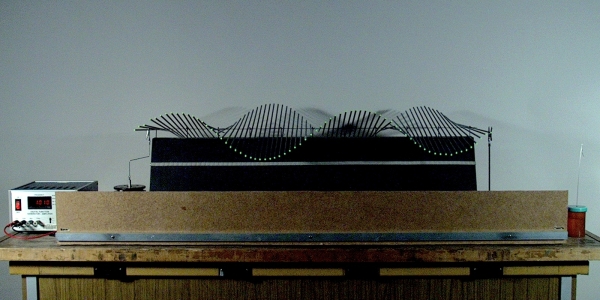
This machine comprises 72 metal rods soldered at intervals of 0.5″ to a spring steel wire running the length of a stand. The steel wire is supported along its length by a series of studs with eyes, which allow for torsional motion of the wire. When you move the end of the rod at either end of the machine up or down, this twists the steel wire, causing the neighboring rods to rotate about the wire as well, and giving rise to a transverse traveling wave. A clamp attached to the rod at the other end of the apparatus (right) allows comparison of wave reflections at free and fixed ends. The small dashpot filled with water (at right, next to the strip light) allows you to use damping to prevent wave reflections. The strip light in front of the machine has an ultraviolet fluorescent tube (“black light”), whose output excites the phosphor that is on the tips of the rods, causing them to glow. This makes it easier to see the motion of pulses or waves.
We have two such machines, which are part of a set (see 40.63 -- Transverse wave machine, all sections). The one shown above has rods that are 18 inches long. The second one has rods that are 9 inches long. Since the moment of inertia of a rod suspended in the middle is Ml2/12, for the two machines these moments differ by a factor of 8. The frequency of torsional oscillation is (1/2π)√(k/I), so the torsional frequencies, and thus the speeds of the waves in the two machines, should differ by a factor of √8, or 2.8. In fact, they differ by slightly more than this, as shown in the table below. The speed at which the wave travels, and whether the reflecting end of the machine is open or closed (vide infra), determine the set of frequencies for which the phase relationship between the original wave and the reflected wave is such that superposition of the two waves gives rise to a standing wave. Below, I refer to the lowest of these frequencies, the fundamental, as the natural frequency of the machine.
You can send a pulse along the machine and show that with the other end of the machine unclamped (open), the pulse is reflected with no change in sign, and that with the other end clamped (closed), the pulse is inverted upon reflection.
You can send a pulse from each end of the machine simultaneously, to show the result of superposition, with pulses of either the same or opposite sign.
If you drive the machine at its natural frequency or a multiple thereof, you can also create a standing wave, as shown above for the machine with two closed ends. In this case, there is a node at each end, and the length of the machine corresponds to integer multiples of half wavelengths. With one end open, you can also obtain standing waves, but in this case there is an antinode at the open end, and you obtain only odd harmonics, where the machine length corresponds to odd integer multiples of quarter wavelengths. You can do this by hand, or you can use a PASCO variable-frequency driver and a function generator, as shown in the photograph above. The photograph shows the fourth harmonic of the machine with closed ends.
You can also drive the machine with the dashpot attached to the open end, to obtain a traveling wave (as opposed to the standing waves described above).
If you wish to freeze the wave motion, you can also use the Strobotac strobe light, connected to the function generator through the frequency-doubling rectifier circuit.
The measured natural frequencies of the two machines with closed ends (all integer multiples of half wavelengths) are:
18″ Machine |
9″ Machine |
||
Fundamental |
0.32 Hz |
Fundamental |
0.90 Hz |
2nd harmonic |
0.52 Hz |
2nd harmonic |
1.6 Hz |
3rd harmonic |
0.76 Hz |
3rd harmonic |
2.4 Hz |
4th harmonic |
1.0 Hz |
4th harmonic |
3.2 Hz |
5th harmonic |
1.3 Hz |
5th harmonic |
4.0 Hz |
6th harmonic |
1.5 Hz |
6th harmonic |
4.8 Hz |
7th harmonic |
1.7 Hz |
7th harmonic |
5.6 Hz |
8th harmonic |
1.9 Hz |
8th harmonic |
6.4 Hz |
The measured frequencies of the two machines with one open end (odd multiples of quarter wavelengths) are: